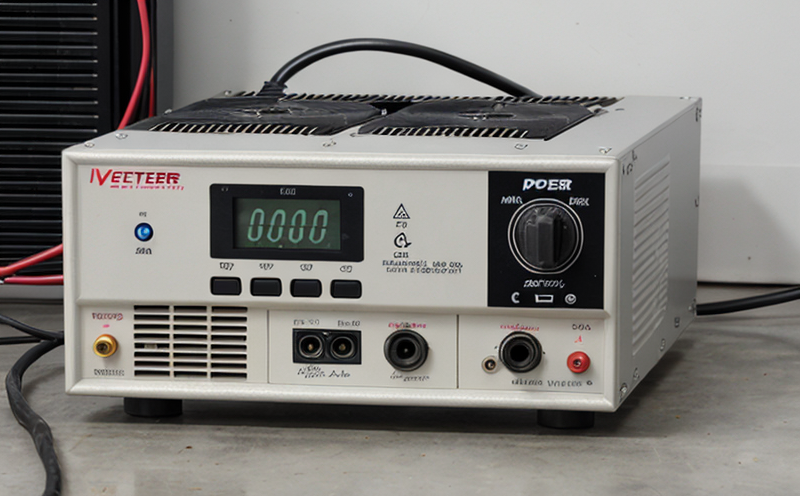IEEE 693 Seismic Testing of Inverter Systems
The IEEE 693 standard is a pivotal document in the field of energy and renewable energy testing, especially for inverters and power electronics. This standard provides a framework to ensure that inverter systems are capable of surviving seismic events without compromising their performance or safety. Seismic testing is crucial as it ensures the resilience of renewable energy installations in areas prone to earthquakes.
Inverters play a critical role in renewable energy systems, converting direct current (DC) from solar panels into alternating current (AC) suitable for grid use. The stability and reliability of these components are paramount for maintaining uninterrupted power supply during natural disasters. IEEE 693 specifies the procedures to subject inverters to simulated seismic conditions that mimic real-world events.
The testing process involves subjecting an inverter system to controlled seismic inputs using shakers or other vibration equipment capable of generating forces and displacements that correspond to different levels of ground motion. The test setup typically includes a mock-up of the inverter installed within a structure, which is subjected to varying levels of acceleration, displacement, and duration.
During testing, engineers monitor several key parameters such as power output, frequency stability, voltage regulation, and harmonic distortion. These metrics help determine if the inverter can operate safely and efficiently under seismic conditions. Compliance with IEEE 693 ensures that the tested inverters meet stringent performance criteria, enhancing public safety and grid reliability.
Real-world applications of this testing include installations in earthquake-prone regions like California, Japan, and Chile. By ensuring compliance with IEEE 693, manufacturers can gain confidence in their products' resilience during seismic events, reducing the risk of failure that could lead to power outages or safety hazards.
- Quality Assurance: Ensures consistent product quality by identifying potential weaknesses early in the testing phase.
- Reliability: Enhances system reliability, which is crucial for critical infrastructure like renewable energy systems.
Why It Matters
The importance of IEEE 693 seismic testing cannot be overstated. In regions where earthquakes are a frequent occurrence, the safety and reliability of inverter systems become paramount. Non-compliance with this standard can lead to significant consequences, including:
- Increased Risk of Power Outages: Failure during an earthquake can result in prolonged power outages, affecting critical services.
- Structural Damage: Inverters not designed for seismic conditions may cause structural damage to the installation site.
- Safety Hazards: Unstable inverters can pose a risk to personnel and surrounding structures.
By adhering to IEEE 693, manufacturers ensure that their products are robust enough to withstand seismic events. This not only protects the equipment but also enhances public safety by minimizing disruptions in energy supply during emergencies.
The standard is particularly relevant for organizations involved in renewable energy projects, where uninterrupted power supply and system reliability are critical. Compliance with IEEE 693 helps these entities meet stringent regulatory requirements while reducing potential liabilities associated with non-compliance.
Quality and Reliability Assurance
The IEEE 693 standard offers a structured approach to quality assurance, ensuring that inverter systems are capable of surviving seismic events. The testing process involves several key components:
- Test Setup: A mock-up of the inverter is installed within a structure that can simulate real-world conditions.
- Seismic Inputs: Controlled inputs are applied to replicate different levels of ground motion, ensuring comprehensive coverage.
- Monitoring Parameters: Key performance indicators such as power output, frequency stability, voltage regulation, and harmonic distortion are continuously monitored during testing.
The test results provide a detailed evaluation of the inverter's ability to withstand seismic forces without compromising its operational parameters. This comprehensive approach ensures that only robust and reliable inverters pass the tests, thereby enhancing overall quality assurance.
Compliance with IEEE 693 is not just about meeting regulatory requirements; it also builds trust among stakeholders and enhances brand reputation. By demonstrating commitment to safety and reliability, manufacturers can gain a competitive edge in the market, attracting more clients and partnerships.
Environmental and Sustainability Contributions
The IEEE 693 standard plays a significant role in promoting sustainability by ensuring that renewable energy systems are resilient to seismic events. By reducing the risk of power outages during earthquakes, these systems can continue to provide clean and reliable energy, minimizing disruptions and environmental impact.
- Reduced Carbon Footprint: Continuous operation of renewable energy systems helps reduce reliance on fossil fuels, lowering greenhouse gas emissions.
- Economic Benefits: By ensuring uninterrupted power supply, these systems contribute to economic stability and resilience in affected areas.
The standard also promotes the use of sustainable materials and manufacturing processes, further enhancing its environmental contributions. Compliance with IEEE 693 not only supports sustainability goals but also aligns with broader industry initiatives aimed at reducing carbon footprints and promoting green energy solutions.
Moreover, by ensuring that inverter systems are resilient to seismic events, the standard helps protect critical infrastructure and public safety, contributing to a more sustainable and resilient society. This dual focus on environmental and social sustainability makes IEEE 693 an essential tool for manufacturers and organizations committed to green energy initiatives.





